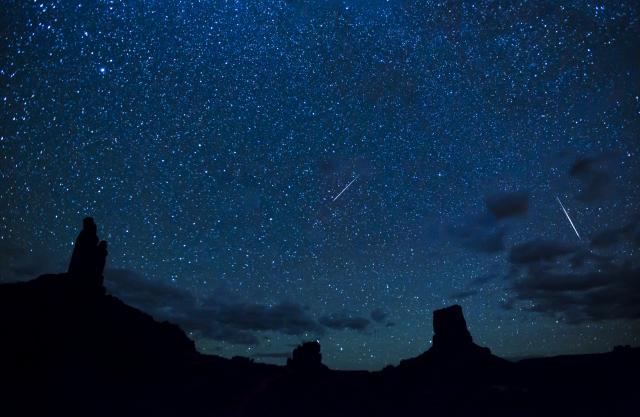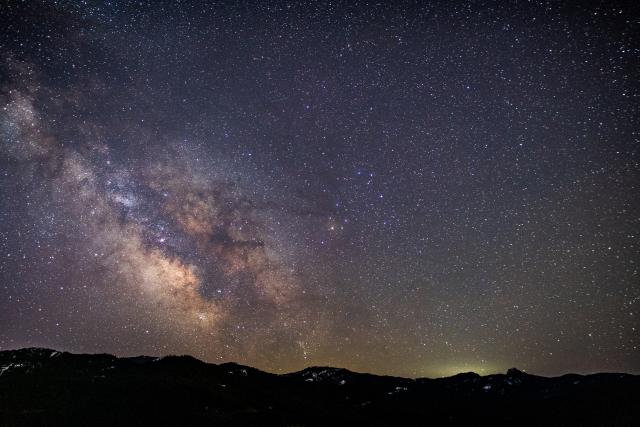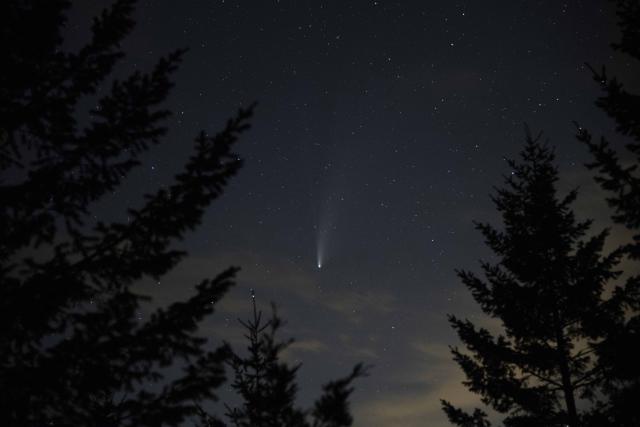You are viewing ARCHIVED content published online before January 20, 2025. Please note that this content is NOT UPDATED, and links may not work. Additionally, any previously issued diversity, equity, inclusion or gender-related guidance on this webpage should be considered rescinded. For current information, visit https://www.blm.gov/blog.
Let photography light your imagination during International Dark Sky Week
By: Derrick Henry, HQ Public Affairs Specialist
Deep night and just off a trail, a photographer framed a landscape enrobed in gradients of darkness. Above, the inclined Milky Way’s stars, gas and dust directed attention to the galactic core, orts of incoming light looking fresh at 26,000 years old. The shutter opened for a few seconds. The scene of dim earth and ornate sky poured into digital memory. This spring, during International Dark Sky Week, which runs through April 30, there is no better time to be that photographer. First to either learn or to improve, and second, to appreciate the value of skies masked in darkness, the default state of the universe.
Public lands managed by the Bureau of Land Management offer incredible opportunities for photographing -- or simply appreciating – the sky at night. For example, the Massacre Rim Dark Sky Sanctuary, managed by the BLM in northwest Nevada, offers fantastic night-sky views, including of the Milky Way and the distant lanes of gas and dust that obscure much of the galactic core 26,000 light-years away. In fact, the International Dark-Sky Association in March 2019 designated Massacre Rim one of the darkest places on Earth. The association is among many that promote International Dark Sky Week.

International Dark Sky Week’s origins go back to 2002, when Jennifer Barlow, a high schooler from Midlothian, Virginia, saw someone on the Internet propose that an annual night of dimmed outdoor lights could help people enjoy the night sky. Acting on the idea, Ms. Barlow’s efforts led to National Dark Sky Week, first observed in the United States in April 2003. Now called International Dark Sky Week, many organizations recognize the event, always held during the week of the new moon in April.
Stargazing and photography are two simple ways to appreciate dark skies.
At California's Amboy Crater National Natural Landmark, you’ll see the night sky slowly snap into view above a nearly symmetrical cinder cone -- a natural wonder here pointing to the natural wonder up there. In Colorado, the Garden Park Fossil Area offers plenty of night sky above jagged land to appreciate and photograph. In Utah’s Valley of the Gods, a photograph taken by Bob Wick, now retired from the BLM, shows white-hot particles of the Perseid Meteor Shower racing at 130,000 miles per hour, at 3,000-degrees Fahrenheit.
For those with night photography experience, this week is a good reminder to start thinking about nightside picture-taking and checking your gear. For beginners, this is a good time to practice near home or in the backyard. At the end of this article, we have some tips from Kyle Sullivan, a BLM public affairs specialist in Medford, Oregon, who does extensive work with night photography.

“Spring is a great time because we are entering Milky Way season, when it returns from winter vacation in the southern hemisphere. Public lands are the perfect place to say, ‘Welcome Back,’” said Sullivan. “Currently the core of the Milky Way rises very early in the morning. As we approach summer, look for it to rise before midnight. From June to August, it’s visible for most of the night. Later in the year, during fall, the core appears as night falls.”
Taking pictures at night can seem challenging. But the night provides a unique perspective, a more controlled pace, and a different feeling than shooting during the day. Few photographic activities let you apply imagination and creativity to the same scene over and over. The quiet of star and night landscape photography are the perfect background to stretching your photography skills.
At a night photography class led by BLM photographers in 2018 near Montrose, Colorado, instruction began long after golden hour. The class, made up of other photographers from various Department of the Interior agencies, used stars as targets to lock their focus. The cameras, mounted on tripods, were then configured using formulas from earlier instruction. For about two hours, everyone practiced in the moonlight and used red headlamps to scout out positions on a trail in Black Canyon of the Gunnison National Park.

Then the moon set. The Milky Way assumed prominence.
For a few hours, land and sky were the teachers as the photographers adjusted for the changing conditions and took notes. The Milky Way, other celestial objects, and the dark landscape patiently awaited their portraits. Someone pointed out the Summer Triangle, an asterism of three nearly equally bright stars at its vertices. Vega. Altair. Deneb. Those who looked in that direction also happened to be looking down the spiral arm containing our sun. Standing on a knob of earth, a small group made up a few of their own constellations in the same way you can make out shapes in clouds. Human imagination flourished in the slow-motion passing of night.
Twenty years ago, when a high school student began work on what’s now an international week of celebrating darkness, she wanted people to experience the wonder of the night sky. That basic message retains its original power. And with public lands offering views that reinforce Ms. Barlow’s efforts, we continue to share our common heritage of a natural night sky.
Note: Bob Wick (retired), Kyle Sullivan and Derrick Henry, all of the BLM, were instructors during a BLM-led Department of the Interior series of photography classes in Montrose, Colorado, in July 2018. Classes, including night photography, were held on various lands managed by DOI agencies.

Bonus: Picture the Dark
By Kyle Sullivan, Public Affairs Specialist.
Can you take pictures in the dark? Of course, you can! Here are some tips and tricks getting started in using your camera to create unique images.
Step 1: Learn about night sky shooting: My favorite resource for photographing the night sky is the Lonely Speck website. This website provides tutorials on how to shoot and post-process night sky photos. The site includes a comprehensive gear guide that focuses on night sky photography. They even have reviews for shooting the Milky Way on cell phones. This website helped me go from no experience to pro in one night sky shooting session.
Step 2: Gear and equipment: I’m currently shooting with a Nikon D850 with a Rokinon 24mm f/1.4 lens. I’ve also shot with a Canon 60D. The lower the f rating, the more light is let in. Wide angle lenses help capture the foreground and the night sky. You’ll also want a sturdy tripod for long exposure photos. One way you can make your tripod more stable is to hang a heavy bag off the hook to help anchor it. I sometimes use a re-useable shopping bag filled with rocks for this purpose.
Step 3: Figure out where to go: One of the best resources for finding dark skies is the light pollution map. This map helps you find the darkest places to see the most stars. It also has some recommendations for specific places. Local topography can also help shield you from light pollution. For example, look for low spots or canyons to help block out light pollution from nearby communities.
Step 4: Figure out when to go: The moon phases have a huge impact on the number of stars you can see. A full moon will light up the landscape like its daytime and hide most of the stars. A new moon creates the darkest skies, but you’re the foreground will likely just be a silhouette. The new moon is ideal for first time night sky shooters because it allows you to focus on capturing the stars and makes post processing easier. For more challenge, shoot when the moon is within ¼ of a new moon, which will light up some of the foreground while still preserving most of the stars. Celestial events, like meteor showers, can add a unique element to your photos.
Step 5: Share the love! Not everyone knows how amazing the night sky is! It takes the human eye about 30 minutes to fully acclimate to the dark. This means that flashlights, lanterns, campfires, car lights, etc., can impact the amount of stars you see. Your home may also be contributing to light pollution. Visit this page to learn about how your outdoor lighting might be impacting dark skies and what you can do to preserve this endangered resource.
Attachments
Related Stories
- Celebrating Winter Solstice 2025 at the Meadowood SRMA
- Progress on Public Lands: BLM 2025 Trump Administration Accomplishments | January 20 - December 31, 2025
- Popular posts: BLM's most viewed blogs of 2025
- Take a First Day Hike on Your Public Lands
- Using science to uncover mysteries of the Mesa archaeological site in Alaska
